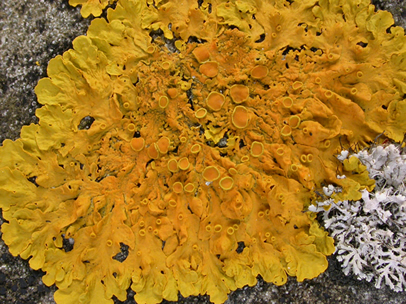LICHENS OF BRITISH COLUMBIA

Orange wall lichen (Xanthoria
parietina),
photo by Daryl Thompson.
Visit the E-Flora BC lichen atlas pages.
Visit the lichen photo gallery on the Ways of Enlichement web site.
Introduction to Lichens
Lichens are an interesting group. They represent a symbiotic association of a fungus and usually a green algae or cyanobacterium. Sometimes the association is with a yellow-green or brown algae. The fungi usually makes up the majority of the lichen. The body of the lichen differs notably from either fungi or algae, and lichens are usually quite distinctive.
Lichens grow in places where there is little soil, and are found on a variety of substrates, including rock surfaces, tree trunks, and on the ground. The fungus provides water and nutrients for the algae, and the algae provide food for the fungus. Some lichens prefer sites with high pH (calcareous sites), while other prefer lower pH.
Lichens reproduce both sexually, through spores, and asexually through vegetative reproduction.
Lichens on E-Flora BC
The list of lichens used on E-Flora BC for British Columbia was provided by Trevor Goward and Curtis Bjork. The lichen atlas pages we currently present are based upon the two volumes of the Lichens of British Columbia:
and
While these publications are presently on-line, we have extracted the species information from the keys, and display this information on E-Flora BC, with permission.
Although we use the two volumes of the Lichens of British Columbia in E-Flora BC, note that these are now much out-of-date. Since their production, new species of lichens have been found in BC by Trevor, Curtis and other lichenologists, including more than 200 as-yet undescribed lichen species, and nomenclature has changed. These researchers are presently working on current information on the lichens of the province.
Lichens in British Columbia
Goward (1999) provides some key and interesting facts about Cladoniaceae in western North American. The following summary is extracted directly from BEN #209, by Trevor Goward. Read BEN for the complete article.
Bird, C.D. & R.D. Bird. 1973. Lichens of Saltspring Island. Syesis 6: 57-80.
Irwin M. Brodo, Sylvia Duran Sharnoff, and Stephen Sharnoff. 2002. Lichens of North America. Yale University Press in collaboration with the Canadian Museum of Nature.
Goward, T. 1993. Notes on the lichens of the Tatshenshini and Alsek Valleys (preliminary report). Unpublished paper, Clearwater, B.C. 23 pp.
Goward, T. 1995. Lichens of British Columbia: Rare Species and Priorities for Inventory. MoF, Research Program and MoELP, Wildlife Branch. Working Paper. 34 pp.
Goward, T. 1996. Lichens of British Columbia: Rare Species and Priorities for Inventory. Res. Br., B.C. Min. For. and Hab. Protect. Br., B.C. Min. Environ., Lands and Parks, Victoria, B.C.
Goward, T. & T. Ahti. 1992. Macrolichens and their zonal distribution in Wells Gray Provincial Park and its vicinity, British Columbia, Canada. Acta Bot. Fennica 147: 1-60.
Goward, T., I.M. Brodo & S.R. Clayden. 1998. Rare Lichens of Canada. A Review and Provisional Listing. Committee on the Status of Endangered Wildlife in Canada Report. 74 pp.
Goward, T., O. Breuss, B. Ryan, B. McCune, H. Sipman & C. Scheidegger. 1996. Notes on the lichens and allied fungi of British Columbia. III. The Bryologist 99(4): 439-449.
Goward, T., P. Diederich & R. Rosentreter. 1994. Notes on the lichens and allied fungi of British Columbia. II. The Bryologist 97(1): 56-62.
Goward, T. & B. Goffinet. 1993. Nephroma silvae-veteris, a new lichen (Ascomycotina) from the Pacific Northwest of North America. The Bryologist 96(2): 242-244.
Goward, T, B. McCune, D. V. Meidinger. 1994. The Lichens of British Columbia: Illustrated Keys. Part 1: Foliose and Squamulose Species; MoF, Research Program, Special Report No. 8. 181 pp.
Goward, T. & W.B. Schofield. 1983. The lichens and bryophytes of Burns Bog, Fraser Delta, southwestern British Columbia. Syesis 16: 53-69.
Goward, T. & G. Thor. 1992. Notes on the lichens and allied fungi of British Columbia. I. The Bryologist 95(1): 33-37.
Noble, W.J. 1982. The lichens of the coastal Douglas-fir dry subzone of British Columbia. Univ. B.C., Vancouver, B.C. PhD Dissertation.
Ohlsson, K.E. 1973. New and interesting macrolichens of British Columbia. The Bryologist 76(3): 366-387. Ryan, M.W. 1991. Distribution of bryophytes and lichens on Garry oak. Univ. Victoria, Victoria, B.C. MSc. Thesis.
Thomson, J.W. 1984. American Arctic Lichens. 1. The Macrolichens. Columbia University Press, New York. 504 pp.
Thomson, J.W. & T. Ahti. 1994. Lichens collected on an Alaska Highway expedition in Alaska and Canada. The Bryologist 97(2): 138-157.
Thomson, J.W. 1997. American
Arctic Lichens. 2. The Microlichens. The University of Wisconsin
Press, Madison. 675 pp.
Weber, W.A. & S. Shushan.
1959. Lichens of the Queen Charlotte Islands, Canada, collected
in 1957 by Dr. Herman Persson. Svensk Bot. Tidskr. 53(3): 299-306.
Recommended citation: Author, date, page title. In: Klinkenberg, Brian. (Editor) 2021. E-Flora BC: Electronic Atlas of the Flora of British Columbia [eflora.bc.ca]. Lab for Advanced Spatial Analysis, Department of Geography, University of British Columbia, Vancouver. [Date Accessed]
E-Flora BC: An initiative of the Spatial Data Lab, Department of Geography UBC, and the UBC Herbarium.
© Copyright 2021 E-Flora BC.